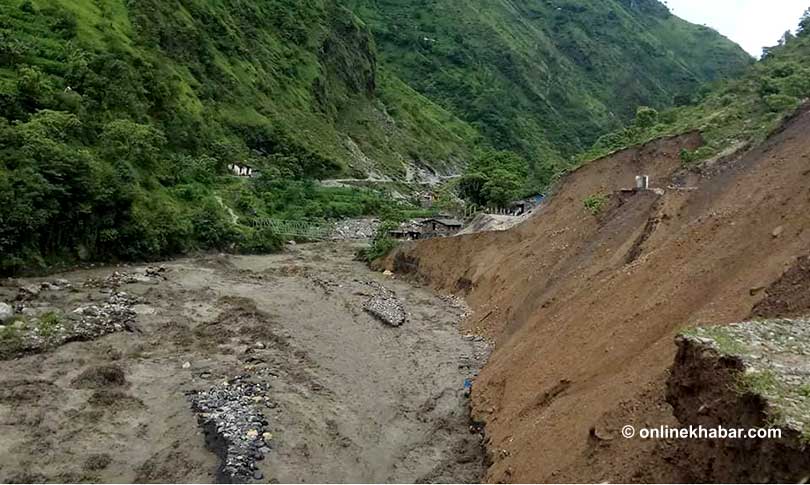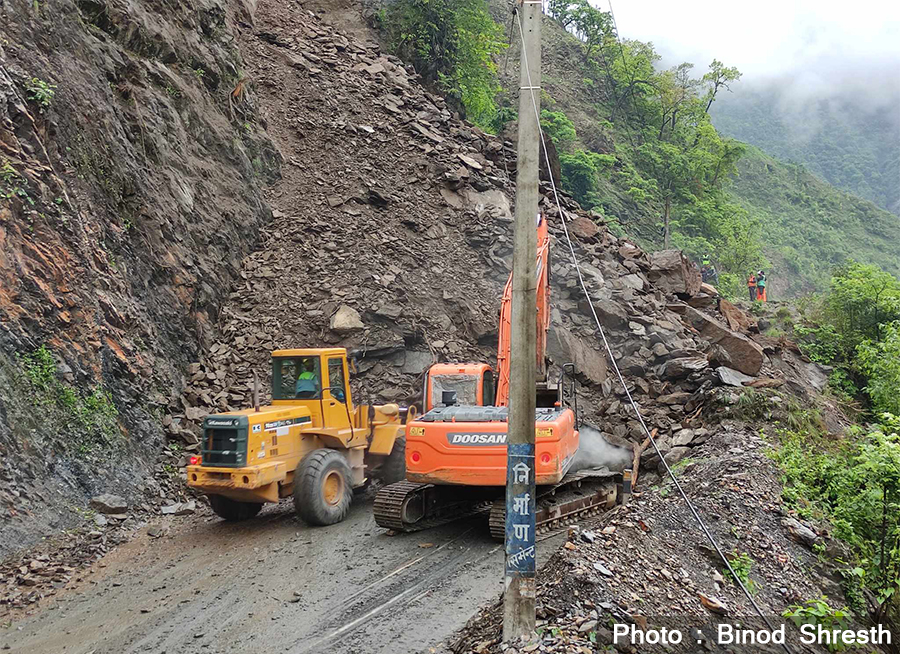
Nepal, in the Hindu Kush Himalayan arc centre, has a rugged terrain with steep slopes, fractured rocks, and fast weathering. Nepal ranks among the world’s most landslide-prone regions, as evidenced by NASA’s global landslide catalogue. Nepal accounted for 10 per cent of all fatal landslides in the global non-seismic landslide database. In Nepal, a staggering 80 per cent of the annual rainfall pours down during just four months, from June to September.
The concentrated rainfall pattern and fragile geology in Nepal are believed to be the main causes of most landslides. The simultaneous rise in road construction and landslide occurrences suggests that landslides are not solely natural events triggered by rainfall alone. Roads are crucial for socioeconomic development, but the landslides triggered by non-engineered and haphazard cutting of hillsides for road construction contradict the primary purpose of building local roads.
Studies have shown that the number of landslides within 100 meters of a road is twice as high as those outside this range. This shows landslides are more common in areas intersected by roads or located near them.
Since 2000, the length of local roads has surged by 1,300 per cent, with their expansion accelerating further. At every local level, prioritising road construction has become a key development focus. With Nepal’s local roads expanding nationwide under sustainable development goals, it’s increasingly urgent to comprehend the interplay among landslides, rainfall, and roads.
Road construction and landslides
Five significant concerns regarding road construction that may contribute to landslides include: i) the steepness of road cut slopes, ii) insufficient or ineffective slope protection measures, iii) the absence of surface/subsurface drainage systems, iv) sidecasting of loose excavated spoil below the road, and v) vegetation removal during excavation and spoil sidecasting.
Additionally, the use of excavating equipment in geologically sensitive zones without adequate investigation into its impact on surrounding soils has made many previously stable slopes unstable. Roadside landslides are broadly attributed to six types as in the figure below. (I) Debris flows originate from excavated material stored downhill from the road, (II) deeper seated landslides that are accommodated by poor road (IIa), and freeze-thaw in joints that can result in bedrock failures (IIb); (III) Shallow failures near the road, resulting from excessively steep road cuts, could potentially be mitigated through planting, (IV) shallow landslides caused by over steepening that include potentially stabilising roots from vegetation; (V) Deeper-seated failures, potentially triggered by excessive steepening of road cuts and involving bedrock, are possible landslide mechanisms near the road.

In mountainous areas, road construction typically involves three main cross-section choices: full-cut, full-fill, and part-cut/part-fill. Full-cut cross-sections are cost-effective as they require minimal compaction and eliminate the need to fill retaining walls.
Landslides are triggered in local roads as they often involve cutting hillslopes excessively high or steeply without geological and hydrological considerations. The Department of Roads (DoR) in Nepal offers guidelines for cutting heights and slope gradients, suggesting a maximum cut slope gradient of 1:0.3 for hard rock and 1:0.8 for general soils. However, local roads in Nepal often deviate from these recommendations, featuring steeper cut slopes.
Absence of vegetation and its effects

Steeply cut soil slopes can stabilise post-excavation during the dry season due to matric suction in soils above the groundwater table. However dissipation of the same through infiltration, seepage, or groundwater rise in monsoon results in slope failures. The widespread practice of cut-and-throw side-casting of full-cut sections along roadsides creates large amounts of excavated spoil, known as “silverfill,” which strips away natural vegetation, which previously contributed to stability.
This absence of vegetation increases water reaching the soil and intensifies raindrop impact, leading to slope instability and erosion. Also, non-engineered roads impact hydrological pathways in two ways: firstly, by intercepting precipitation on their surface; and secondly, when construction exposes subsurface flow interfaces, intercepted water flows as runoff. Road construction without proper drainage can cause rainwater to accumulate resulting in gullying, soil erosion, roadside failures, and shallow landslides. Furthermore, landslide material may be carried to streams and rivers, causing sedimentation issues, damaging infrastructure such as bridges and hydropower plants, degrading water quality, and harming aquatic habitats.
From a solution perspective, when the slope angle exceeds recommended values, road construction authorities should consider constructing slope protection structures. Various low-cost toe support measures like gabion walls, stone masonry walls, and composite masonry walls could be employed on local roads. Gabion walls are favoured for their potential affordability, ease of construction with local materials, and ability to accommodate settlement without rupture.
However, their effectiveness would depend on the shape, size, and quality of the rocks used. Using weathered or undersized stones could potentially compromise the wall’s integrity. Similarly, for effective water management on roads, aimed at controlling and redirecting surface and intercepted subsurface flow into natural channels, is essential to safeguard slopes from erosion and instabilities.
DoR, Nepal, recommends the implementation of catch drain ditches and cascades for surface water management, as well as horizontal drain holes and subsurface drains for subsurface water management, as mitigation measures against landslides. Drain ditches, which are commonly constructed on the cut slope side of the road, could play a crucial role in capturing and diverting surface and subsurface water to designated discharge points such as cross-drains.
In the absence of these ditches, surface runoff could follow the road contour, potentially flowing downslope or into channels upon encountering low points in the topography. The practice of side-casting excavated spoil along roadsides should be monitored due to its potential adverse effects. It leads to the removal of natural vegetation, exacerbating slope instability and erosion. Efforts should prioritise minimising harm to vegetation during this process to maintain ecological balance and slope stability.























